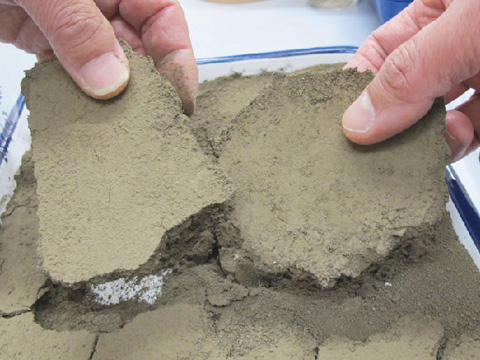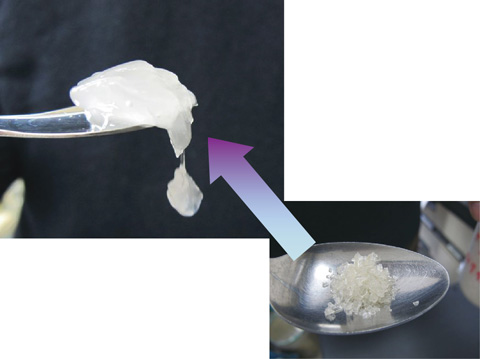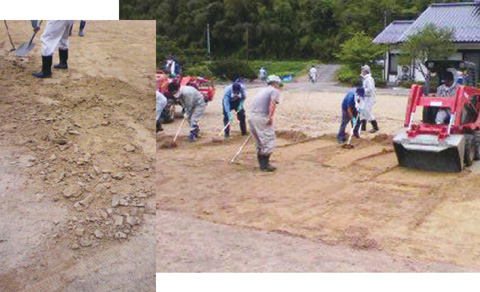
Fig.1-20 Solidification of soil flakes

Fig.1-21 Swelling of the poly-ion complex

Fig.1-22 Decontamination test in Date-City, Fukushima
The poly-ion complex and clay method (PCCM) is a surface soil treatment technique for the decontamination of soil (removal of surface soil) and the prevention of recontamination of the cleaned soil (containment of radioactive cesium in heavily polluted soil). This method is effective for long-term decontamination of broad areas such as fields and village forests, where decontamination with time and care is needed.
In the PCCM, the poly-ion complex is a gel material formed by mixing cationic and anionic polymers (called “poly-ions”) that can solidify and stick to surface soils and inhibit soil dust discharge and mud water runoff, while the clay strongly adsorbs and firmly fixates cesium ions and can prevent radioactive cesium from migrating and diffusing into deeper soil layers. Both the poly-ions and clay are non-toxic and safe substances. In addition, large quantities can be procured, and their use was demonstrated following the Chernobyl nuclear power plant accident. Notably, the poly-ions cannot firmly fixate cesium, while the clay is easily dried and broken and thus can fly apart as dust. Therefore, the PCCM combines both poly-ion complexes and clay in order to overcome the limitations of each.
The most important feature of the PCCM is its long-term durability in the environment. The poly-ion complex is solid when dried. Although it becomes soft and swollen when exposed to water, it does not flow out from the soil owing to rainfall because it is very sticky and has the properties of the gel. In addition, the poly-ion complex can effectively inhibit soil dust discharge in both dry and wet areas. With these characteristics, radioactive cesium in heavily polluted soil can be contained for a long time, and thus, recontamination with soil dust and mud water, even in heavily polluted areas, can be avoided. Fig.1-20 presents a photograph of soil flakes solidified with the poly-ion complex. Fig.1-21 shows the poly-ion complex dried (lower right) and swollen after absorption of water (upper left). Meanwhile, the clay can fixate radioactive cesium for a long time. In addition, a clay suspension can draw up cesium from deeper soil layers to the surface during the course of drying as a result of the phenomenon known as “suction.” “Suction” is the effect of capillary action as the suspended solution percolates into the soil voids. When the fine clay particles in the surface layer are exposed to sunlight and wind, they dry and shrink, and the wet and swollen particles in the suspension within the deeper soil layers can be siphoned off to the surface. The swollen fine particles that percolate into the deeper soil layers can trap radioactive cesium that is weakly bound by coarse non-clay soil particles and bring radioactive cesium to the surface via suction. The soil decontamination technique using the poly-ion complex was tested in Oguni, Ryozen, Date-city, Fukushima in July 2011. The grounds of two community centers, 1500 m2 in total area, were decontaminated by removing a 2 cm soil surface layer, and 85~90% of the radioactive cesium was cleared off (Fig.1-22).